
views
Following Best Practices

Use your steamer on cotton, silk, wool, and polyester dresses. Most blended fabrics can be steamed, as can most finer materials like cashmere, silk, satin, and lace, but those materials should always be tested beforehand if they haven't been steamed before. If you have a dress that is pleated or has creases, you'll want to use an iron rather than a steamer. A steamer can't create or reinforce creases.
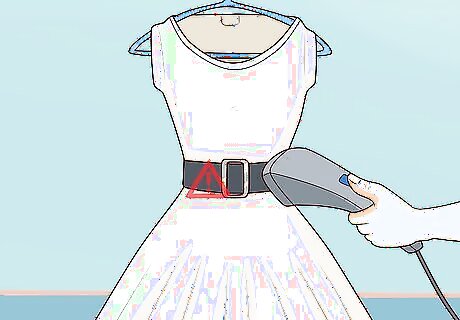
Avoid steaming dresses that have leather or suede materials. These materials are more likely to melt or warp if you apply steam to them. If the leather or suede doesn't cover a large part of the dress, you could always try covering that section with a clean towel and steaming around it. Just use caution and don't hold the steamer over the edge between leather and fabric for too long. Similarly, any kind of plastic or waxy material shouldn't be steamed.
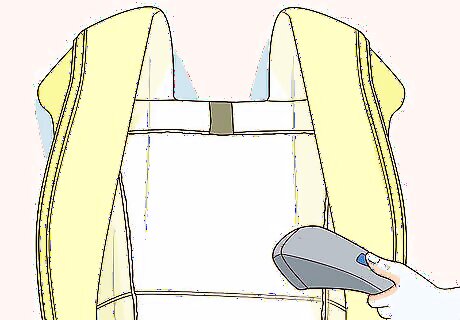
Test delicate materials before starting the steaming process. Steam can discolor, warp, and even shrink certain kinds of fabrics. Run the steamer along the inside of the dress in the back. Choose a small section, just 4 to 5 inches (10 to 13 cm) square. Steam that section as you normally would, and then let it dry and cool down. Check the section afterwards for signs of discoloration or shrinkage. If there aren't any, then you're good to go! If you don't think the dress should be steamed, you may want to take it to a professional cleaner.

Steam expensive garments through a white cloth to protect them. If you're steaming wrinkles out of a wedding dress or any other expensive garment, avoid getting steam directly onto the dress itself. Instead, use a white cloth as a barrier between the steamer and your dress. A clean white towel or handkerchief would work well for this process. Simply hold it against the dress as you steam it, moving it along with you as you go from section to section. Store your more expensive dresses, like a wedding dress or gown, on padded hangers to protect the shoulders from getting misshapen (since a steamer can't reshape fabric).
Using a Handheld Steamer

Hang your dress on a hook in a non-cramped space. Choose a location where you'll have ample room to maneuver the steaming wand and where you'll be able to move the dress around easily. A hook on the back of a door would work well, or you could even hang it off of the shower rod in your bathroom. Always hang the dress from a hanger, and then hang the hanger from a hook (don't hang the dress directly on a hook). Some steamers come equipped with stands. If yours does, feel free to use it! If you aren't ready to invest in a steamer yourself, try borrowing one from a friend first. That way you can try it out and make sure it's an investment you want to make.
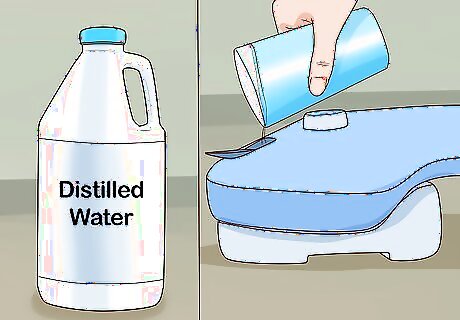
Fill up the steamer with distilled water. Non-distilled water has minerals in it, which can cause a hard, white deposit to appear in your steamer. Buy distilled water from the store, and put fresh water into your steamer every time you use it. If you notice a build-up of minerals in your steamer (if you've been using non-distilled water), fill up the reservoir 1/3 of the way with white vinegar and 2/3 of the way with distilled water. Run the steamer until most of the liquid is gone, and then dump out the liquid that remains. Fill up the reservoir again with distilled water only, and run the steamer again to make sure all the vinegar is gone.
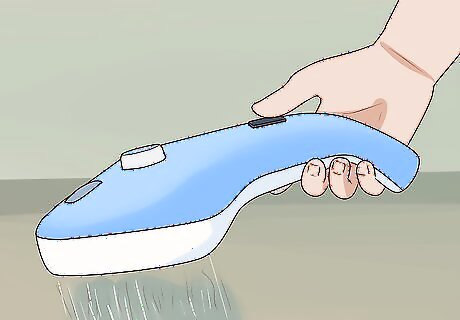
Warm up the steamer and depress the main button for 1 minute. This gets rid of the old reservoir water and purifies the nozzle so that it doesn't transmit any bacteria to your dress. Keep holding in the main button until there is a continuous stream of steam. If you use your steamer often, it might not take the full minute to get the steamer ready. Just make sure there are no more “coughs” or bursts coming from the steamer before you actually move on to the dress.
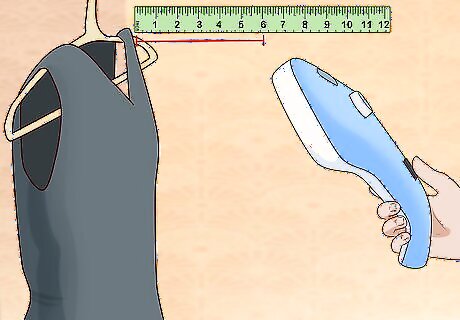
Pull the dress taut and steam it section by section to eliminate wrinkles. Hold the steamer about 6 inches (15 cm) away from the dress in one hand. Use your other hand to pull the fabric of the dress taut. Work in sections from the top to bottom, and spend 1 to 2 minutes on each area, moving the steamer in long, slow, downward strokes until you see the fabric relaxing. For example, if you have a long-sleeved dress you could start by steaming each arm, then the front chest area, the midsection, and the bottom front section. Then turn the dress over and do the top of the back, the middle of the back, and the bottom of the back. If you place the steamer too close to the dress, you'll leave watermarks and the steam will get backed up, which could result in a burst of steam that damages the dress when you finally pull it back. For wedding dresses made of tulle, lace, and chiffon, work in small circles rather than long strokes. Wedding dresses made of other materials should be steamed by a professional.
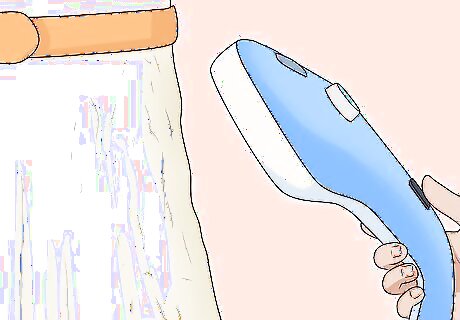
Tackle heavy wrinkles by applying steam directly to them. If there are areas that are heavily wrinkled, hold the steamer over them for 30 to 60 seconds at a time. Keep pulling the fabric taut and watch to see when the wrinkles start relaxing. Once they're gone, continue with steaming the rest of the dress. Remember to not press the steamer directly against the fabric, even when directly treating big wrinkles. It could burn or discolor the fabric.
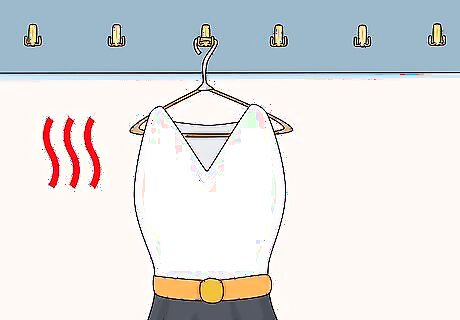
Let the dress dry completely before you put it on. After you steam the dress, leave it alone for about 10 minutes so it has time to dry and cool off. While the dress won't be wet, it will be a little damp from the steam. Putting it on right away could make the wrinkles set back in. A great way to keep your clothes in good shape is to take a few minutes to steam your garments after you've worn them. So when you get home, take some time to steam your dress before putting it back into the closet.
Running a Hot Shower

Hang your dress from the shower rod. Put your dress onto a sturdy hanger, and then hang that off of a shower rod. Position the hanger so that the dress isn't too close to the showerhead (you don't want the dress to get wet). You can do this before you take your next shower, or anytime you need to steam your dress. This is a great way to steam dresses and other garments when you've been traveling and don't have access to a steamer. While using the shower is great for getting rid of minor wrinkles, it may not get out really large, heavy creases in the fabric.

Close any windows or doors. If the bathroom has windows or doors leading to other rooms, close as many of them as you can. This will keep the steam in the main area of the bathroom, which will help it permeate your dress a lot better. Don't run the exhaust fan.

Run a hot shower for 10 minutes. Turn on the water as hot as it will go (unless you're showering, in which case just turn it to whatever temperature you prefer), and then let the water run for 10 minutes. If you aren't showering or using the bathroom, you can leave the room and do something else while your dress is getting steamed. The hotter the water, the steamier the room will get. And the steamier the room, the better your dress will turn out.
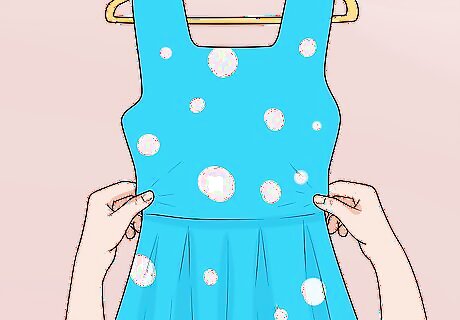
Pull the dress taut in sections to remove the wrinkles. After the 10 minutes are up, go ahead and turn off the shower. Leave your dress hanging and pull each section of the dress taut to erase the wrinkles. For example, if there were wrinkles running across the skirt of your dress, pull the bottom of the skirt down so that the fabric is stretched tight. This eliminates the wrinkles because the fabric was relaxed by the steam. Pull the bottom of the dress, the sleeves, and the midsection if the dress has a waist. You can also use your hands to smooth down the dress and look for other wrinkles you need to pull out.
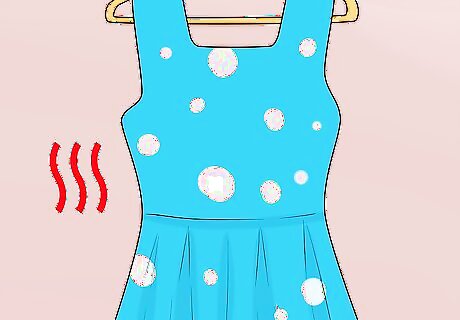
Let the dress dry completely before you put it on. The dress may not be wet, exactly, but it might have some moisture from the steam clinging to it still. Leave it alone for 10 to 15 minutes to let it dry and cool off before you wear it. If there are wrinkles that didn't come out, you may need to iron the material or use a steamer.

















Comments
0 comment